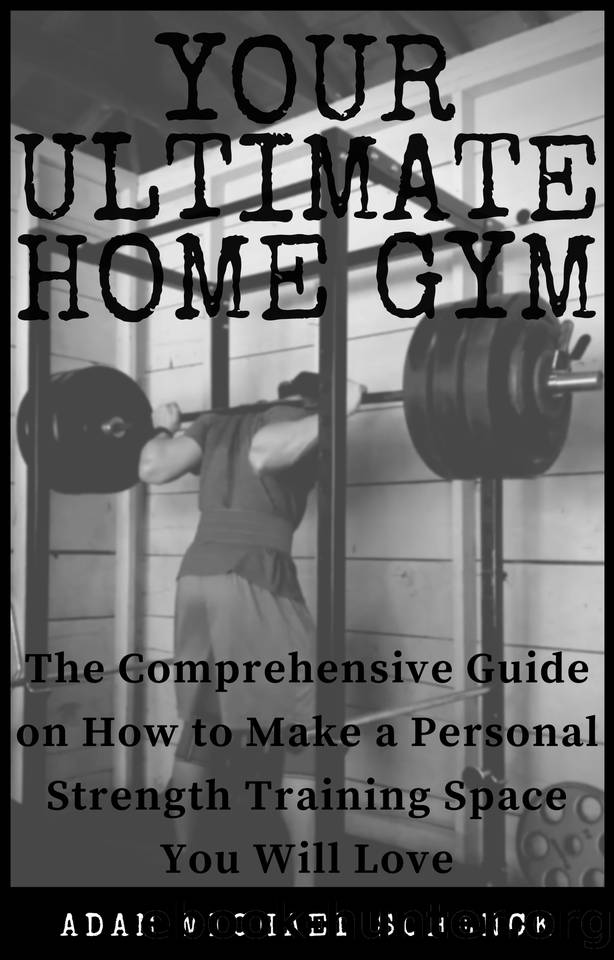Your Ultimate Home Gym: The comprehensive guide on how to make a personal strength training space you will love by Adam Michael Schenck

Author:Adam Michael Schenck [Schenck, Adam Michael]
Language: eng
Format: azw3
Published: 2020-09-30T16:00:00+00:00
Chapter 5: Track Your Progress and Stay Motivated
Setting up your programming should be simple, but the training sessions should be both simple and hard.
I use two formats for training sessions that I spread out by at least 48 hours. I perform 3 sets of 5 reps (3X5) for each of the lifts. Refer to Rippetoeâs Practical Programming for guidance and planning.
From one session to the next, I aspire to increase the weight by 2.5 pounds or 5 pounds, with two 1.25-pound plates and two 2.5-pound plates, respectively. If I canât hit the 3X5 minimum, Iâll do the same weight the next session and try to hit 3X5.
This is similar to the standard linear progression program as described in the Starting Strength program.
A Session
Squat, deadlift, overhead press
B Session
Squat, row, bench press
I do the A session, then the B session, and then AB again. You might want to plan your week, like do ABA one week and then BAB, and so on. I just do AB ongoing and donât worry about the week.
You can do a Monday/Wednesday/Friday split and take the weekend off, and there are other variations. If I feel like I need rest, I will wait a day, and instead do light cardio.
If youâve been doing a bodybuilding-style program, this program wonât be very impressive. Each session only has 45 total âwork setâ repetitions. However, if you include a reasonable warmup for each lift and take video of yourself, itâs easy for these workouts to go well over an hour. Thatâs not something to brag about, though, because we want to perform the MED or minimum effective dose, and wasted time is time not spent recovering.
A warmup set goes up in weight from either the bar (45 pounds) or 135. I like to go up by 90 pounds for each warmup set. So, in a session, a squat or deadlift progression might look like this:
Warmup Sets
135X5. 1-minute rest (add plates).
225X5. 2-minute rest.
315X5. 4-minute rest.
Working Sets
365X5. 5-minute rest.
365X5. 6-minute rest.
365X5. Done.
If 365 sounds like a lot, remember that I started with 185 three years agoâand I thought I was strong then! This progression would take a total of roughly 24 minutes, and my heart rate gets highâlike itâs pounding out of my chest.
The 3X5 program finds the sweet spot between intensity, volume, and your bodyâs ability to recover. It challenges your anaerobic system and aerobic system, too. Program for yourself, but do so in an informed way.
Minimum Effective Dose
The âminimum effective doseâ (or MED) concept is the idea that the smallest dose of stress is best in order to produce a desired outcome. Itâs similar to âprogressive overload,â where in order for your muscle to grow, you need to force your body to adapt to a stress that is beyond what it has previously experienced.
Training should give you the right amount of stress from which to recover. You donât want to under-dose, because your body wonât need to recover. You donât want to overdose, because it will take too long to recoverâso long that your body will just return to baseline without making an adaptation.
Download
This site does not store any files on its server. We only index and link to content provided by other sites. Please contact the content providers to delete copyright contents if any and email us, we'll remove relevant links or contents immediately.
Tools of Titans by Timothy Ferriss(7813)
Bodyweight Strength Training by Jay Cardiello(7674)
Born to Run: by Christopher McDougall(6894)
Inner Engineering: A Yogi's Guide to Joy by Sadhguru(6440)
Asking the Right Questions: A Guide to Critical Thinking by M. Neil Browne & Stuart M. Keeley(5356)
The Fat Loss Plan by Joe Wicks(4620)
Bodyweight Strength Training Anatomy by Bret Contreras(4466)
Yoga Anatomy by Kaminoff Leslie(4100)
Science and Development of Muscle Hypertrophy by Brad Schoenfeld(3971)
Dynamic Alignment Through Imagery by Eric Franklin(3919)
ACSM's Complete Guide to Fitness & Health by ACSM(3824)
The Four-Pack Revolution by Chael Sonnen & Ryan Parsons(3793)
Exercise Technique Manual for Resistance Training by National Strength & Conditioning Association(3786)
Bodyweight Strength Training: 12 Weeks to Build Muscle and Burn Fat by Jay Cardiello(3779)
Yoga Anatomy by Leslie Kaminoff & Amy Matthews(3738)
The Ultimate Bodybuilding Cookbook by Kendall Lou Schmidt(3707)
Yoga Therapy by Mark Stephens(3572)
Nutrition for Sport, Exercise, and Health by Spano Marie & Kruskall Laura & Thomas D. Travis(3556)
Nutrition for Sport, Exercise, and Health by Marie Spano & Laura Kruskall & D. Travis Thomas(3548)
